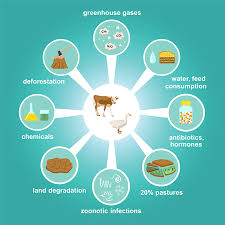INTENSIVE FARMING-FEATURES, ADVANTAGES & DISADVANTAGES
Defintion
Intensive farming is basically intensification of agriculture and mechanization system that aims to maximize yields from available per unit land through various means, such as heavy use of pesticides, chemical fertilizers, plant growth regulators and mechanized agriculture, based on analysis of growing conditions.
Optimal use of these resources and machines produces significantly greater crop yields per unit of land than extensive agriculture, which uses little capital or labour. Therefore, a farm using intensive agriculture will require less land than an extensive agriculture farm to produce a similar profit.
Key Features
- It is a type of farming includes both crop plants and animals, with higher levels of input and output per unit area. It is characterized by higher use of inputs like capital and labour, and higher crop yields per unit land area.
- This technique includes planting multiple crops per year, reducing the frequency of fallow years, and improving cultivars.
- Being holding size small, intensive agriculture becomes necessity and also important to feed the increasing population. Hence it is the key source of food worldwide.
- This intensification and mechanization is also applied to the raising of livestock such as cows, pigs and chickens, being held indoors known as factory farms.
- The main benefits of intensive farming include sufficient food supplies at affordable prices.
However, increased chemical applications are dangerous both to nature and the human body. Intensive farming causes environment pollution and induces many health issues due to poisonous agents.
IMPACT OF INTENSIVE FARMING (IF)
- It has been threatening global environment through the loss of ecosystem services and also global warming has led to the emergence of new parasites as well as re-emergence of parasites by creating favorable conditions for parasite growth and is responsible for 80% of tropical deforestation.
- IF kills beneficial insects and plants, degrades and depletes the fertility of soil. It also decreases biodiversity and destroys natural habitats. Such farming practices, livestock, and clearing of land for agriculture are significant contributors to the build-up of greenhouse gases in the atmosphere.” There are both advantages and disadvantages of intensive farming, but compared to the disadvantages, the advantages are less and thus ultimately, it focuses on for moving to sustainable agriculture.

Advantages of Intensive Farming (IF)
1. High crop yield
IF provides high crop yields. In fact the current market demands are achievable through intensive farming because the yields are produced in large quantities on a small piece of land.
2. Provides more variety of food
IF provides more variety of food for human consumption and also food for animals. Since IF requires high input, makes it more practical to only focus on one production area.
3. Efficient Technique
The farmer makes more profit by maximizing yields on a small piece of land as compared to the conventional farming methods that needed large tracts of land but produced less yields, thus it is more economical and efficient.
4. Affordable food prices
Intensive farming requires less space and produces more yield than the invested inputs, so it makes availability of food on affordable price to common consumers. It has substantially helped in solving the world’s hunger problem.
5. Sustainability of food supply
Intensive farming offers the advantage of high crop productivity with the possibility of meeting the food demands of current huge population. Besides, it requires less amount of land thus, significantly contributes to economies of scale in meeting the ever-escalating demand for food supplies.
6. Helps in ensuring regulated farming
Disadvantages of Intensive Farming
1. Excessive use of agro-chemicals
Intensive farming involves the application of various chemical pesticides, fertilizers, herbicides, insecticides, and acaracides. When these chemicals are used, they not only destroy their intended targets such as pests, weeds and parasites but also contaminate the food products which ultimately go to human body and domestic animals that cause many health problems including cancer. The insecticides and pesticides also kill beneficial insects, microbes and birds which contribute to biodiversity loss.
2. Poor living and hygiene for livestock
IF involves the use of various chemicals, growth hormones and excess crowding on a small space, which results in poor living conditions and hygiene for the livestock. It causes infections and various diseases.
3. Deforestation and Environmental loss
The removal of trees, slush and burn techniques, and the clearing of forest areas for agriculture has led to massive deforestation and soil erosion. Consequently, natural habitats and wild animals have been badly affected as the destructive practices have persistently contributed to habitat loss. Heavy use of agro-chemicals contaminates soil, wildlife habitats, and water bodies, causes eutrophication.
4. Risks on human health
Environmental exposure of humans to agrochemicals is common and results in acute and chronic health effects, including acute and chronic neurotoxicity (insecticides, fungicides, fumigants), lung damage (paraquat), chemical burns (anhydrous ammonia), and infant methemoglobinemia (nitrate in groundwater). A variety of cancers also have been linked to exposure to various pesticides, particularly hematopoietic cancers. A higher risk of cancer and birth defects is due to such chemicals enters in food chain. Besides, chemical growth hormones and other chemicals are used to increase production.
5. Taste and quality loss
IF mainly focuses on higher yield but not on quality and nutritious food products. As a consequence, the quality of foods sourced from intensive farming often lacks the nutrition values and taste as compared to those produced using the conventional farming methods and organic farming.
6. Job & income Loss
Intensive farming as opposed to traditional farming utilizes less space, labor and resources to produce much greater volumes. This makes very hard for traditional farmers to compete. IF reduces job opportunity per unit of food produced which means less job creation opportunities to farmers.
Read more…
TYPES OF FARMING- SYSTEM OF FARMING
WHAT IS ORGANIC FARMING- KEY FEATURES
INTEGRATED FARMING SYSTEM
SUBSISTENCE FARMING-HISTORY & TYPES